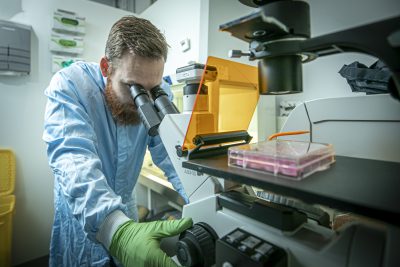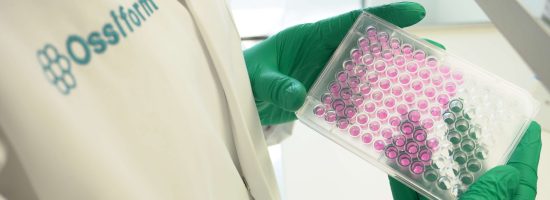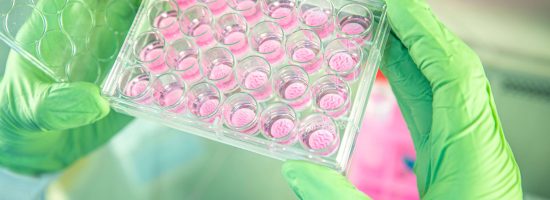What are organoids and why are they important?

What are organoids and why are they important?
What is an organoid?
Organoids cover a wide range of three-dimensional multicellular in vitro human tissue constructs that are used to mimic its corresponding in vivo organ in research .
The word ‘organoid’ is relatively new and most commonly describes constructs derived from stem cells – either pluripotent or adult stem cells – from various organs. Still, stem cell-derived organoids are not the only type of organoid. In fact, there are a wide variety of organoids that are created through different types of cell culture systems. These include 3D bioprinted scaffolds, organ-on-chip, and microfluidics-based 3D cell culture models.
How organoids work
The concept behind every type of organoid is the integration of human tissue architecture into traditional 2D monolayer cultures.

Organoids can increase the efficiency of in vitro testing, for example by providing better insight into the cell communication between cell types.
The environment in which cells grow greatly impacts cell structure and function. What happens in 2D cell cultures, which lack the native 3D tissue architecture, is an alteration in cell morphology – and thereby in cellular functions. In consequence, the models do not accurately emulate in vivo cell behavior. This results in a strong dependence on parallel use of animal models, especially during drug development.
On the other hand, the three-dimensional structure – which lays the ground for organoid formation. This allows cells to grow and self-organize correctly according to the relevant tissue. Thereby, the 3D cell culture system utilizes the respective advantages of animal models and 2D cultures. The 3D cell organization facilitates cellular communication and secretion. This promotes huge advantages over 2D cell cultures, and the cells exhibit advances in features like morphology, viability, response to stimuli, drug metabolism, in vivo relevance, and proliferation.
Organoids thereby become more representative of real tissues and consequently provide a higher in vivo relevance and predictive accuracy than do 2D models.
Organoid applications

Illustration of a bone organoid model and its potential applications. A scaffold-based three-dimensional multicellular bone tissue construct can be created through differentiation of stem cells and optionally additional cell lines, proteins, and cytokines .
Even though the development of more complex models for mimicking human organs is rapidly progressing, organoids do lack some complexity. Firstly, organoids generally lack the vasculature of organs. Secondly, some types of organoids cannot recapitulate the structure of the modeled organ. Lastly, some stem cell-derived organoids are relatively immature. The organoids are therefore not a complete image of the organ, but rather a snapshot of the specific condition, or a means to analyze cellular mechanisms without using animals.
Nonetheless, the capacity of organoids to emulate human organs and their responses to therapies with improved cell structure and function can translate more accurate findings to human physiology and pathology.
In research, organoids can be used to perform more complex examinations of human tissue physiology, organ-specific infectious diseases, genetic diseases, and cancer than those provided by 2D cell cultures. As a result, organoids may give better insight into the cell communication between cell types. Thereby increasing the efficiency of in vitro testing.
Implications for drug development
Moreover, in the last decade, organoids have been applied in drug testing during the preclinical phase. The aim is to estimate how the drug will influence cellular events in the respective organ. With enhanced cell viability, response to stimuli, and drug metabolism, the organoid represents a promising screening platform for drug development that could prove a key driver in the transition toward faster, more effective, and more ethical drug development processes.
Creating an organoid
Organoids may be created through various types of 3D cell culture systems. Each has its advantages and limitations, making them suitable for various research purposes and setups.
Major advantages of the scaffold-based 3D culture system include:
- The scaffold structure allows cells to assemble into 3D models and populate to significant numbers.
- It establishes cell-cell and cell-matrix interactions and allows for realistic drug testing in lifelike porous structures wherein drug perfusion is uneven and where bacteria and cancer cells may hide in pores.
- It ensures reproducibility with no batch-to-batch variability and easy handling.
- It allows for complex cell co-cultures and longer-term studies with consistent and repeatable cell growth.
In addition to matrix structure, other components of the environment in which cells are grown also influence cell adhesion, growth, and behavior. Important factors to account for also include scaffold material and stiffness.
Ossiform’s porous and bioceramic P3D Scaffold is especially durable in bone and cancer research applications as it is designed to emulate the microenvironments of human bone. The scaffold provides an accurate replica of the calcified bone composition and stiffness of the tissue and thus facilitates a more realistic growth.
Scaffold-based organoids for enhancing bone and cancer research
Bone-organoid models can illuminate how different drugs might affect the natural bone remodeling process.
An organoid that emulates the microenvironments of human bone can be cultured on a P3D Scaffold using mesenchymal stem cells (MSCs). The bone tissue is modeled by seeding MSCs onto the scaffold and subsequently differentiating them in osteogenic media to develop a natural diversity of osteocytes and osteoblasts. The combination of the 3D environment provided by the P3D Scaffold and MSCs effectively models the bone formation part of the bone remodeling process, facilitated by the osteoblasts. To recapture the full remodeling process, an osteoclastic cell line can be added to the 3D environment.
Once an organoid line is established, the three-dimensional tissue model can translate useful findings to human physiology and may be used to test several treatments. Further experiments with the organoid models could include seeding of other cell lines, such as cancer cell lines, onto the P3D Scaffold for investigating tumor biology and metastases to bone. The resulting 3D tumor models can then be used to test several anti-cancer drugs with predictive accuracy as the models maintains relevant cell receptors.
If you want to learn more about how to create scaffold-based organoid models – download our protocol on how to 3D culture human mesenchymal stem cells on P3D Scaffolds.
Download our Protocol: How to 3D Culture Human Mesenchymal Stem Cells – Creating an in vitro tissue model on P3D Scaffolds
The protocol covers guidelines on how to seed and 3D culture stem cells on P3D Scaffolds in a 24–well plate to create a three-dimensional multicellular in vitro tissue construct.
References
- Simian, M. and M.J. Bissell, Organoids: A historical perspective of thinking in three dimensions. J Cell Biol, 2017. 216(1): p. 31-40.
- Clevers, H.C., Organoids: Avatars for Personalized Medicine. Keio J Med, 2019. 68(4): p. 95.
- Schutgens, F. and H. Clevers, Human Organoids: Tools for Understanding Biology and Treating Diseases. Annu Rev Pathol, 2020. 15: p. 211-234.
- Marx, V., Models: stretching the skills of cell lines and mice. Nat Methods, 2014. 11(6): p. 617-20.
- Hung, B.P., et al., Three-Dimensional Printing of Bone Extracellular Matrix for Craniofacial Regeneration. ACS Biomater Sci Eng, 2016. 2(10): p. 1806-1816.
- Gupta, N., et al., Microfluidics-based 3D cell culture models: Utility in novel drug discovery and delivery research. Bioeng Transl Med, 2016. 1(1): p. 63-81.
- Kim, J., B.K. Koo, and J.A. Knoblich, Human organoids: model systems for human biology and medicine. Nat Rev Mol Cell Biol, 2020. 21(10): p. 571-584.
- Illustration created with Biorender.com


